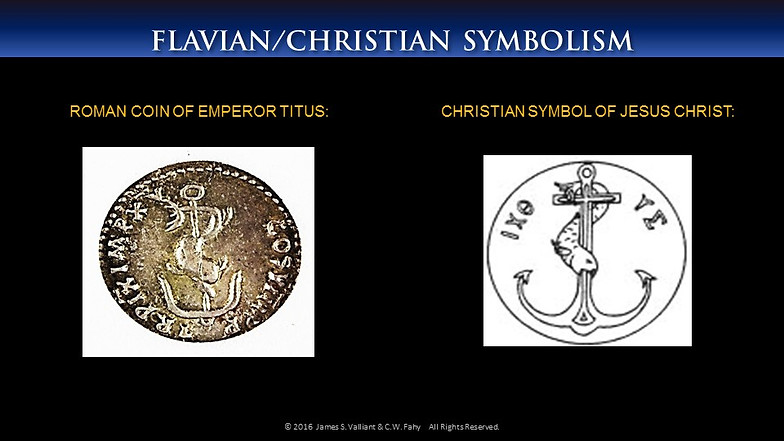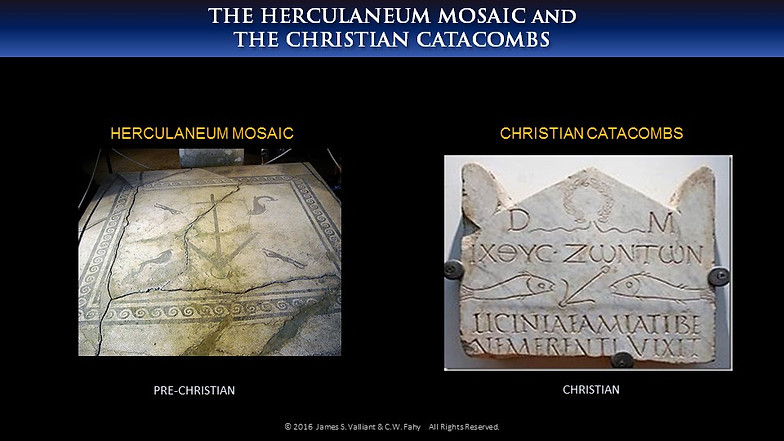Robert M. Price review of Creating Christ
James S. Valliant and Warren Fahy,
Creating Christ: How Roman Emperors Created Christianity. Crossroad Press, 2018. xix = 361 pp. ISBN 978-1-949914-62-7. $19.99. Reviewed by Robert M. Price.
I know of at least five other scholars who have set forth a case that the Christian religion was created and promulgated by the Flavian Imperium to serve as an opiate for the ever-rebelling Jewish messianists. All have taught me, but I never saw a way to take the theory seriously till I read Valliant and Fahy’s new book,
Creating Christ (not to be confused with Paul Louis Couchoud’s classic Mythicist book
The Creation of the Christ). R.G. Price’s 2016 book
Deciphering the Gospels Proves Jesus Never Existed, argues persuasively that the central concern of Mark’s gospel is to offer a theodicy for God’s abandoning Israel to the Roman siege engines and swords. The events of 70 CE were a pretty major blow to Jewry, so, Mark tells us, it must have been the punishment for something pretty darn big! How about the rejection of God’s Son and messiah? Yeah, that oughta do it! Price was not reiterating the historic Christian judgment of Jews for something they (i.e., their ancestors) actually did. No, his point is that the whole rejection story was a fiction posited as an explanation after the fact. It would have been the same kind of thinking the Chronicler used when he attributed bad deeds to certain kings who had short reigns: otherwise, would not God have blessed them with longer ones?
In effect, Valliant and Fahy have carried this theory farther and in a surprising direction. They see the gospels concerned, as all of them are, with the fall of Jerusalem, its Temple, and its sacrificial system not trying to justify divine Providence but rather as justifying the Roman conquest, defending not God but Titus! And here our authors tread eerily close to the case recently pressed with new vigor by Mike Sullivan and others on behalf of Preterism. That is the doctrine (originally set forth by James Stuart Russell in his 1878 book
The Parousia) that Jesus predicted the end of the age to transpire in the generation of his contemporaries, not centuries or millennia later, and that it would follow upon the destruction of the Temple—and that this prediction was fulfilled right on time! The Second Coming, then, happened long ago and is not to be expected in the future. Did Jesus return without anyone noticing? Well, it was supposed to be like the stealthy arrival of a thief in the night, wasn’t it?
Valliant and Fahy agree, but they say that it wasn’t Jesus himself returning, any more than John the Baptist was a literal return of the prophet Elijah. No, Mark and the others expected readers to grasp that the “second coming” of Jesus Christ was actually fulfilled in Titus’ razing of the Jerusalem Temple! This might seem absurd until you ask yourself why on earth the evangelists would preserve or create a grossly embarrassing failed prophecy for Jesus. It would seem either Russell was right or Valliant and Fahy are right.
The bitter pill goes down more easily once you learn that not only did Josephus declare Titus’ father Vespasian (who conducted the Jewish War until he handed it over to Titus to complete) as the prophesied Jewish Messiah, but that so did Rabbi Johanon ben Zakkai! And Romans Tacitus and Suetonius did, too! As scripture had said, the Messiah had come out of the East to rule the nations. Never said he was Jewish. (Similarly, seventh-century Jews were willing to ally themselves with proto-Islamic (“Hagarite”) Arabs to follow Umar al-Faruq as the Messiah, though he was an Arab, not a Jew.) Titus inherited his father’s Messianic status, so both were deemed fulfillments of Messianic prophecy.
Again, this scenario may seem completely outlandish, but it is not. Alexander the Great, having conquered Egypt, tried to make himself palatable to his new subjects by claiming he was the son of Zeus-Amun.
The underlying purpose of the Flavian scheme would have been to throw a wet blanket over the simmering coals of Jewish anti-Roman sentiment by co-opting the religion that had again and again ignited Jewish Zealotry. So they created a kind of “Reform Judaism” whose Messiah (Jesus) praised the faith of Roman centurions, advised Jews to pay Roman taxes and to happily shoulder Roman field packs farther than Roman law required of a Jew, and whose real enemies were not Romans but Jews. The latter had cleverly maneuvered the former into crucifying Jesus even though Pilate declared Jesus innocent. No wonder God slew those murderers and gave the vineyard to better tenants. And the Flavians Titus and Vespasian were the weapons of his justice.
Paul was already spreading a gospel that demolished the wall of the Torah that separated Jew from Gentile. Circumcision was no longer needful. Kosher laws were now moot, and Jesus’ death had stultified sacrifices. Paul was bitterly opposed by Jewish Messianists like Peter and James the Just who considered him an apostate and an Antichrist. Of course, these hallmarks of Jewish national identity were precious to Jewish militants, and Valliant and Fahy very naturally cast James, Peter, and their faction as armed militants spreading sedition throughout the Diaspora, repudiating Caesar in the name of another king, Jesus. (Hugh J. Schonfield was of the same opinion.)
Is there any solid evidence for the wholesale Roman fabrication of Christianity as we know it? Or is it all simply an interpretive paradigm to re-construe the textual data of the New Testament (not that that’s unimportant!)? Valliant and Fahy lay great store by numismatic evidence, plus ancient mosaics and tombstones which copiously display the “trademark” of Vespasian and Titus (ultimately and admittedly borrowed from the earlier Seleucid emperors): the design of an anchor (sometimes a trident) flanked by dolphins or with Flipper curled around the anchor haft. Why is this important? Well, at the very same time the Flavians were minting these coins, Christians widely embraced this symbol for themselves. Christian use continued long afterward, though as of Constantine it was replaced by the more familiar cross. Given the impression reinforced by movies like
The Robe and
Demetrius and the Gladiators, that Rome engaged in unremitting, widespread persecution of Christians, it would seem extremely unlikely for Christians to appropriate for themselves the favorite logo of their persecutors. But it would make plenty of sense for them to use the symbol of Flavianism if the latter supported their religion—having largely created it in the first place.
It would serve our authors’ thesis well if we could accept the genuineness of the notorious Testimonium Flavianum of Josephus, contained in his epic
Antiquities of the Jews. A Flavian partisan actually mentioning Jesus! Valliant and Fahy are willing to accept a trimmed-down version of the precious paragraph, defending the basic authenticity as best they can. Pardon me, but I am fully convinced by recent work on it that Eusebius created it out of whole cloth, as he did the fanciful Jesus and Abgarus letters. See Paul J. Hopper,
“A Narrative Anomaly in Josephus: Jewish Antiquities xviii, 63.” and Ken Olson,
“A Eusebian Reading of the Testimonium Flavianum,” in Aaron Johnson and Jeremy Shott, eds.,
Eusebius of Caesarea: Tradition and Innovations (CHS Research Bulletin, vol. 1.0.11),
As defenders of the
Testimonium always do, Valliant and Fahy appeal to Origen’s comment that Josephus did not believe Jesus was the Messiah. Doesn’t this mean that the copy of Josephus he was reading did at least mention Jesus, even if as a false Messiah like Theudas? No, it does not. Origen was well aware that Josephus hailed Vespasian as the Messiah. That would by itself account for the reference.
Again, these authors invoke Josephus’ story of priestly intrigues leading to the assassination of “James the bother of Jesus called Christ.” Mustn’t this be a reminder of an earlier reference to Jesus? They are very unfriendly to Richard Carrier who would deprive them of this toy. Carrier argues, quite cogently to my mind, that Josephus is referring to the regrettable episode in which Ananus wanted the high priesthood for his own evil self and murdered his rival James son of Damneus. The news got back to the new Roman procurator who righted things by giving Ananas the boot and naming James’ brother Jesus son of Damneus in his place. Carrier shows how this fits the context, unlike a sudden arbitrary mention of James the Just and Jesus Christ.
Valliant and Fahy cannot brook Carrier’s suggestion that the epithet “who was called Christ” is a Christian interpolation. There’s no manuscript evidence for that! Of course there’s pretty much none pro or con early enough to settle the question. They note the seeming peculiarity of Matthew referring to “Jesus called the Christ” (Matt. 27:17). Why not simply “Jesus Christ”? Do our authors realize that some manuscripts of Matthew call Barabbas “Jesus Barabbas”? If that is the original reading, then Matthew’s “called the Christ” makes plenty of sense: Pilate is clarifying which Jesus is which. “Take your pick: Jesus Barabbas? Or Jesus called the Christ?” And that would be the point of the interpolation Carrier posits: a Christian copyist thought, or wanted to think, that Josephus was referring to Jesus Christ and James the Just, so he inserted the specification. But all of this, I think, is beside the point. Valliant’s and Fahy’s theory does not depend on the originality of either Josephan passage.
It further strengthens their argument if we use a wider historical lens. As it happens, we have a perfectly good historical analogy that at least shows that the kind of thing our authors posit did happen back then. I am thinking of the Persian reconstruction of Judaism under Ezra and Nehemiah. It looks as if these Persian agents essentially transformed the old faith of Israel into a local variant of their own religion, Zoroastrianism. Pre-Exilic Judaism knew nothing of an eschatological resurrection and Final Judgment. Its Satan was an agent of Jehovah, not his arch-enemy. There was no dispensational periodization of world history. No virgin-born cosmic Savior. After the Exile, Pharisaism (on the way to becoming “official” Judaism) exhibits all these things, which is why the Sadducees mocked the Pharisees
as Pharisees, i.e., “Parsees,” Zoroastrians. For their part some rabbis considered Zoroaster the same person as Jeremiah’s disciple Baruch. The Second Isaiah called Cyrus the Great “my Messiah,” so why not Vespasian/Titus?
This imposition of the Persian religion upon Judaism was of course designed to reconcile the conquered with the conqueror and, which is the same thing, to assimilate the subject people into the larger empire. Valliant and Fahy make it look very likely that Christianity began the same way.
This book does not weigh in on whether there was an historical Jesus. It really doesn’t affect the thesis either way. But let me suggest supplementing Valliant and Fahy with the work of S.G.F. Brandon, author of
The Fall of Jerusalem and the Christian Church: A Study of the Effects of the Jewish Overthrow of AD 70 on Christianity and Jesus and the Zealots (which Reza Aslan disgracefully ripped off in his
Zealot). Brandon argued quite capably that Jesus was an armed anti-Roman insurgent and was crucified for it. It was no frame-up. Some years later, fearing trouble from Rome, his followers, having become apolitical and spiritualizing the “Kingdom of God” notion (or pretending to?), rewrote the story of their founder to make him a kind of first-century Mahatma Gandhi. Reading this, the Romans would conclude Christianity was nothing to worry about. Tell-tale vestiges of the original version remain, however, and Brandon starts with these to reconstruct the original.
How might Brandon’s theory fit with that of Valliant and Fahy? Rather perfectly, I should say, with one significant change: it wasn’t ex-revolutionary Christians who sanitized and pacified a Jihadi Jesus, but the Flavians! Valliant and Fahy have shown this was exactly their agenda in fabricating “normative” Christianity. The goal in writing the gospels and Acts was not to protect apolitical, purely religious Christianity from Rome by distancing it from still-active radical Christians (“Hey! It’s
them you want to arrest, not us!”). No, the goal was to promote a safe, pro-Roman Christianity to co-opt the radicals. The result would be just the same as in Brandon’s theory. It’s actually but a slight readjustment. And it gives us a Jesus ideally suited to the theory of Valliant and Fahy.







